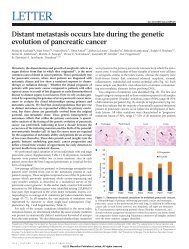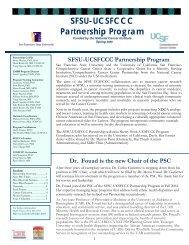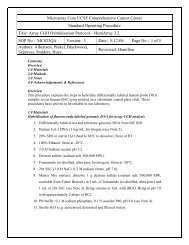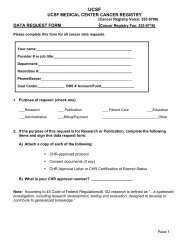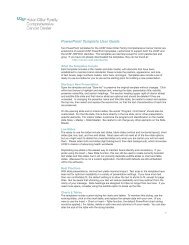Summer 2012 Newsletter - UCSF Helen Diller Family ...
Summer 2012 Newsletter - UCSF Helen Diller Family ...
Summer 2012 Newsletter - UCSF Helen Diller Family ...
You also want an ePaper? Increase the reach of your titles
YUMPU automatically turns print PDFs into web optimized ePapers that Google loves.
Bay Area Breast Cancer SPORE <strong>Newsletter</strong><br />
The 5 th International Workshop on Breast Densitometry<br />
and Mammography-Based Risk Assessment was held<br />
June 9-10, 2011 in San Francisco, with 160 participants<br />
representing more than 50 different institutions from<br />
around the world. Investigators attending presented<br />
research on new methods to measure breast density,<br />
genetics and biology of breast density and use of breast<br />
density in clinical practice to determine at what age to start<br />
screening mammography and how often to be screened.<br />
Breast density research is clinically relevant since it is one<br />
of the strongest risk factors for breast cancer. Breast<br />
density is a radiological term and that describes the<br />
relative amounts of fat, epithelial, and connective tissues<br />
that appear on a mammogram due to differences in X-ray<br />
attenuation. Fat appears radiolucent or dark, while<br />
epithelial and connective tissues are radiographically<br />
dense and appear light or white (Figure 1). When<br />
comparing women that have mostly white on their<br />
mammogram (high breast density) to those that have<br />
mostly dark (low breast density), women with high breast<br />
Page 2<br />
5 th International Workshop on Breast Densitometry and Mammography-Based<br />
Risk Assessment<br />
By Karla Kerlikowske, MD, <strong>UCSF</strong> Breast SPORE Investigator<br />
density are at 4 to 6-fold higher risk of developing breast<br />
cancer. For the purposes of this article, high breast density<br />
is defined as an amount of greater than 50% dense tissue<br />
seen on imaging. Of women undergoing mammography,<br />
32% show high density, which exceeds the prevalence of<br />
most risk factors such as family history of breast cancer.<br />
Key findings presented at the 5 th International workshop<br />
include:<br />
• Volume of breast density measured as either<br />
fibroglandular volume or percent fibroglandular volume is<br />
strongly associated with breast cancer risk and improves<br />
the accuracy of risk assessment over clinical risk factors<br />
alone.<br />
• For women aged 40 to 49 years with high breast density,<br />
and with either a first-degree relative with breast cancer<br />
or history of a prior breast biopsy, the benefits versus<br />
harms for performing mammography every two years is<br />
similar to screening an average-risk woman in her<br />
fifties every two years.<br />
• Women with fatty breasts have a decreased risk of<br />
breast cancer. Women with high breast density have<br />
decreased expression of CD36 that helps<br />
development of fat cells in the breast.<br />
• Women aged 50 to 59 years with low breast density<br />
(fatty breasts) could be screened less often than<br />
every two years.<br />
• High breast density is strongly and positively<br />
associated with breast cancer risk for several tumor<br />
subtypes including estrogen-receptor (ER) positive<br />
breast cancer, triple negative breast cancer and<br />
HER2 positive breast cancer.<br />
• rs10995190 single-nucleotide polymorphism (SNP), a<br />
DNA sequence, is associated with breast cancer risk<br />
and high breast density suggesting that the genetics<br />
of breast cancer and breast density may be linked.<br />
Figure 1: Left panel low<br />
density and right panel high<br />
breast density.<br />
• BreastCare (Breast Cancer Risk Education) study is<br />
evaluating a tablet-based intervention to increase<br />
patient knowledge about her personal breast cancer<br />
risk including factors that increase risk such as<br />
breast density, and increase patient-physician<br />
discussion of risk-reduction practices.<br />
The workshop was chaired by Drs. Karla Kerlikowske,<br />
John Shepherd and Steve Cummings and sponsored<br />
by <strong>UCSF</strong>, Daniel and Phyllis Da Costa Funds of the<br />
CPMC Foundation with contributions from the<br />
California Breast Cancer Research Program,<br />
American Cancer Society and the Matakina<br />
International Limited. The next workshop will be held in<br />
2013.




